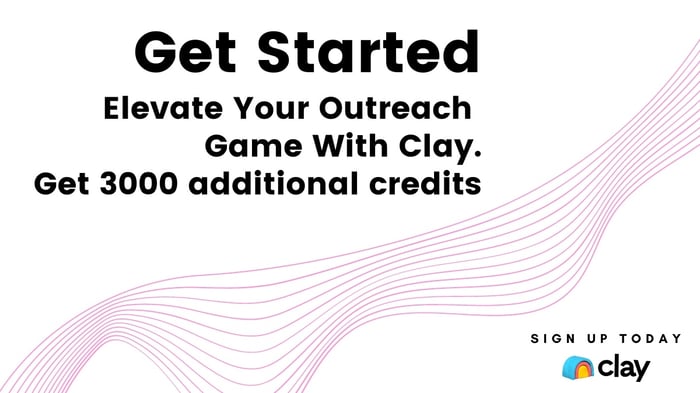B2B Email Outreach: Generic vs Personalised vs Triggers vs Relevancy
In the digital age, where inboxes are overflowing, mastering the art of email outreach is crucial for businesses looking to connect with potential customers and forge meaningful relationships.
However, not all email outreach strategies are created equal.
Let's explore four distinct approaches – generic, personalised, trigger-based, and relevancy-based – and understand how they can be leveraged to achieve your outreach goals.
Generic Email Outreach: The Broad Stroke
Generic email outreach involves sending the same email template to a large list of recipients, often with minimal customisation. It's a "spray and pray" approach that prioritises quantity over quality.
Pros:
-
Efficiency: Generic emails are easy to create and send in bulk, saving time and resources.
-
Reach: They can be used to reach a large audience quickly, potentially generating some leads.
Cons:
-
Low Open and Response Rates: Generic emails often get ignored or deleted, leading to low engagement.
-
Impersonal: They lack the personal touch that resonates with recipients, making it difficult to build relationships.
-
Damage to Brand Reputation: Sending irrelevant or spammy emails can harm your brand image.
When to Use:
-
Early-Stage Lead Generation: Although we rarely recommend a generic approach, if you're just starting and need to build a list of potential leads, generic emails can be a way to cast a wide net. However, it's important to follow up with more personalised communication to nurture those leads.
-
Announcements and Updates: For general announcements or company updates, generic emails can be suitable as the information is relevant to a broad audience.
Personalised Email Outreach: The Human Touch
Personalised email outreach involves tailoring your message to each recipient, referencing their specific interests, needs, or pain points.
It requires more effort but can lead to significantly better results, and using tools Like Clay can help you create personalisation at scale quickly and easily.
Pros:
-
Higher Open and Response Rates: Personalised emails show recipients you've done your research, increasing their likelihood of opening and responding.
-
Builds Relationships: Personalized communication demonstrates genuine interest, fostering trust and rapport.
-
Improved Conversions: Tailoring your message to specific needs makes it easier to move prospects through the sales funnel.
Cons:
-
Time-Consuming: Researching and crafting personalised emails takes more time than sending generic ones.
-
Scalability: Personalisation can be challenging to scale for large outreach campaigns. We recommend using a tool like Clay.

When to Use:
-
High-Value Prospects: For key accounts or high-value leads, personalised emails are essential to demonstrate your commitment and stand out from the competition.
-
Nurturing Leads: Personalisation helps keep leads engaged throughout the sales cycle, increasing the chances of conversion.
-
Post-Sale Communication: Personalised emails can be used to thank customers, offer support, or upsell/cross-sell, fostering loyalty and repeat business.
Trigger-Based Email Outreach: The Timely Nudge
Trigger-based email outreach involves sending emails based on specific actions or behaviours taken by prospects or customers.
These triggers can include website visits, content downloads, social media interactions, or even significant dates like birthdays or anniversaries.
Pros:
-
Relevance: Trigger-based emails are timely and contextually relevant, increasing engagement.
-
Automation: They can be automated using marketing automation tools, saving time and effort.
-
Personalisation at Scale: Triggers allow you to personalise communication without manually crafting each email.
Cons:
-
Requires Tracking: You need to track prospect and customer behavior to identify triggers.
-
Potential for Overcommunication: Too many trigger-based emails can lead to annoyance and unsubscribes.
When to Use:
-
Lead Nurturing: Welcome emails, content recommendations, or re-engagement campaigns can be triggered based on prospect behaviour.
-
Customer Onboarding: Trigger-based emails can guide new customers through the onboarding process, improving their experience and reducing churn.
-
Upselling and Cross-selling: Offering relevant products or services based on past purchases or browsing behaviour can increase revenue.
Relevancy-Based Email Outreach: The Targeted Approach
Relevancy-based email outreach takes personalisation a step further by focusing on delivering the right message to the right person at the right time.
It combines elements of personalisation and trigger-based outreach with a deep understanding of your target audience's needs and pain points.
Pros:
-
Highly Targeted: Relevancy-based emails are laser-focused, delivering content that is most likely to resonate with each recipient.
-
Maximises Engagement: By providing valuable and timely information, relevancy-based outreach boosts open rates, click-through rates, and conversions.
-
Builds Trust: Demonstrating that you understand your audience's needs fosters credibility and strengthens relationships.
Cons:
-
Requires Data and Insights: You need robust data and analytics to understand your audience and deliver relevant content.
-
Complexity: Relevancy-based outreach requires sophisticated marketing automation tools and strategies.
When to Use:
-
Account-Based Marketing (ABM): When targeting high-value accounts, relevancy-based outreach is crucial for delivering personalised experiences at scale.
-
Content Marketing: Providing relevant content recommendations based on past behaviour or interests can nurture leads and drive conversions.
-
Customer Success: Proactively reaching out with helpful tips or resources can improve customer satisfaction and retention.
Conclusion
The ideal email outreach strategy will depend on your specific goals, target audience, and resources.
While generic emails might be suitable in rare cases for initial outreach, personalised, trigger-based, and relevancy-based approaches offer far greater potential for building relationships, driving engagement, and achieving business success.
Remember, the key to effective email outreach is to focus on providing value to your recipients.
By understanding their needs, pain points, and interests, you can deliver timely, relevant, and personalised communication that resonates and inspires action.
As technology continues to evolve, so too will the landscape of email outreach.
Stay informed about the latest trends and best practices to ensure your strategies remain effective and impactful in the ever-changing digital world.
